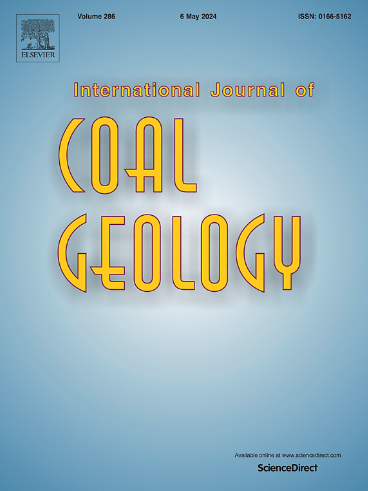解读杜罗石炭系盆地(葡萄牙pej煤田):沉积、成岩和热液过程的地球化学、岩石学和矿物学证据
IF 5.7
2区 工程技术
Q2 ENERGY & FUELS
引用次数: 0
摘要
葡萄牙杜罗石炭盆地(DCB)蕴藏着大量煤矿,其中最重要的是佩霍煤田(Pejão Coalfield)。这项研究综合了岩相学、地球化学和矿物学分析,对石炭盆地的沉积、热液影响和古气候条件进行了研究。岩石学分析将这些煤炭归类为高阶无烟煤 A 类,其中主要的大颗粒矿物是矾石(占 90%)。地球化学分析显示微量元素富集(Ag、As、Pb、Sb 和 V),表明原生沉积输入和后期热液覆盖相结合,含 REE 的磷酸盐(萤石、独居石、氙)和硫酸盐(四面体、波仑石)的存在也说明了这一点。古风化指数(CIA、PIA、WIP、MIA)表明风化强烈,沉积物循环微妙,而古盐度代用指标则表明周期性蒸发事件与短暂的湖沼区有关,可能是嬉水区类型的系统。锆英石分布模式和产地指标表明,锆英石富集程度有限,沉积物循环程度极低,尤其是碳酸盐岩角砾岩和砂岩岩性。这些发现为了解盆地的沉积环境、成岩历史和热液蚀变提供了新的视角,有助于更广泛地了解石炭纪山间盆地。本文章由计算机程序翻译,如有差异,请以英文原文为准。
Deciphering the Douro Carboniferous Basin (Pejão Coalfield, Portugal): Geochemical, petrological, and mineralogical evidence of depositional, diagenetic, and hydrothermal processes
The Douro Carboniferous Basin (DCB) in Portugal hosts significant coal deposits, with the Pejão Coalfield being among the most important. This study integrates petrographic, geochemical, and mineralogical analyses to investigate the sedimentation, hydrothermal influences, and paleoclimatic conditions of the DCB. Petrographic analysis classifies these coals as high-rank anthracite A, with vitrinite as the dominant maceral (>90 %). Geochemical analyses reveal trace element enrichments (Ag, As, Pb, Sb, and V), suggesting a combination of primary sedimentary input and later hydrothermal overprinting, as indicated by the presence of REE-bearing phosphates (florencite, monazite, xenotime) and sulfosalts (tetrahedrite, bournonite).
Paleoweathering indices (CIA, PIA, WIP, MIA) suggest intense weathering and subtle sediment recycling, while paleosalinity proxies indicate periodic evaporation events linked to ephemeral lacustrine zones, possibly playa-type systems. The REE distribution patterns and provenance indicators suggest a limited zircon enrichment, supporting minimal sedimentary recycling, especially intracarboniferous breccia and sandstone lithologies. These findings provide new insights into the basin's depositional environment, diagenetic history, and hydrothermal alteration, contributing to a broader understanding of Carboniferous intermontane basins.
求助全文
通过发布文献求助,成功后即可免费获取论文全文。
去求助
来源期刊

International Journal of Coal Geology
工程技术-地球科学综合
CiteScore
11.00
自引率
14.30%
发文量
145
审稿时长
38 days
期刊介绍:
The International Journal of Coal Geology deals with fundamental and applied aspects of the geology and petrology of coal, oil/gas source rocks and shale gas resources. The journal aims to advance the exploration, exploitation and utilization of these resources, and to stimulate environmental awareness as well as advancement of engineering for effective resource management.
 求助内容:
求助内容: 应助结果提醒方式:
应助结果提醒方式:


